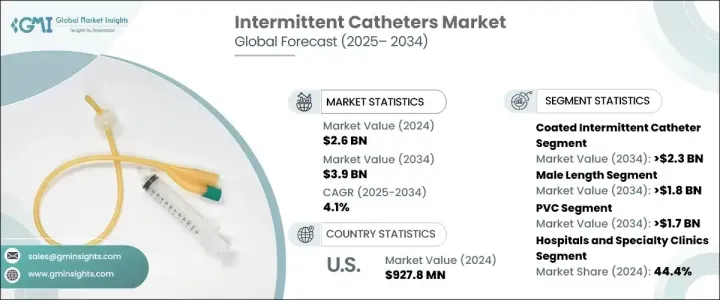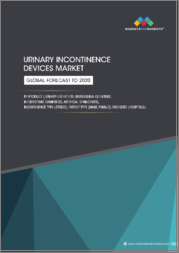
|
시장보고서
상품코드
1716455
간헐 카테터 시장 기회, 성장 촉진 요인, 산업 동향 분석, 예측(2025-2034년)Intermittent Catheters Market Opportunity, Growth Drivers, Industry Trend Analysis, and Forecast 2025 - 2034 |
||||||
간헐 카테터 세계 시장은 2024년에 26억 달러에 이르렀고, 2025년부터 2034년까지 연평균 복합 성장률(CAGR) 4.1%로 성장할 것으로 예상됩니다.
요실금, 신경인성 방광장애의 유병률 상승, 지속적인 방광관리 솔루션을 필요로 하는 급속한 고령화로 시장은 꾸준한 성장을 이루고 있습니다. 자기 카테터 유치의 장점에 대한 의식 증가와 유치 카테터를 대체하는 보다 안전한 옵션을 중시하는 건강 관리 시스템이 수요를 증가 시키고 있습니다. 의료 종사자와 환자 모두 보다 편안하고 위생적인 선택을 요구하고 간헐 카테터가 선호되는 솔루션으로 부상했습니다. 친수성 코팅과 항균 코팅과 같은 카테터 기술의 혁신은 환자의 사용감과 안전성을 높이는 데 매우 중요한 역할을 합니다.

이러한 최신 디자인은 마찰을 줄이고 감염 위험을 최소화하기 때문에 만성 비뇨기 질환 환자의 장기 사용을 촉진합니다. 게다가 재택치료와 환자 중심의 케어 모델에 대한 주목이 높아짐에 따라, 보다 양질의 생활을 위해서 자기 관리형의 솔루션을 선호하는 사람이 늘어나고, 간헐 카테터의 채택이 증가하고 있습니다. 특히 고령자들 사이에서 척수 손상, 다발성 경화증, 전립선 관련 문제가 증가하고 있는 것이 선진지역과 개발도상지역 모두에서 일관된 수요를 촉진하고 있습니다. 또한 간헐 카테터 사용 편의성과 환자 구매 편의성 향상을 목적으로 하는 지원 상환의 틀과 건강 관리 노력도 이 시장에 이익을 가져다 줍니다.
| 시장 범위 | |
|---|---|
| 시작 연도 | 2024년 |
| 예측 연도 | 2025-2034년 |
| 시작 금액 | 26억 달러 |
| 예측 금액 | 39억 달러 |
| CAGR | 4.1% |
간헐 카테터 시장은 주로 코팅 카테터와 비코팅 카테터로 나뉘며, 예측 기간 동안 코팅 카테터 수요가 높아질 것으로 예측됩니다. 2025년부터 2034년까지 연평균 4.4%의 성장률로 성장할 것으로 예측됩니다. 특히 친수층을 가진 코팅 카테터는 습윤시 미끄러워져 삽입시의 불쾌감이나 요도 외상을 크게 줄일 수 있습니다. 신형 카테터를 선택하는 경우가 많습니다. 요로 감염(UTI)의 위험이 줄어들고, 카테터 삽입이 보다 원활하게 이루어지기 때문에 코팅 카테터는 헬스 케어 프로바이더에게도 환자에게 선호되는 옵션이 되고 있습니다.
또한 간헐 카테터 시장은 다양한 해부학적 요구에 대응하기 때문에 남성용, 여성용, 소아용 등 길이별로 구분되어 있습니다. 연평균 4%의 성장률을 보이며 성장하여 2034년까지 18억 달러의 수익을 창출할 것으로 예상됩니다. 남성용 카테터는 남성 해부학적 구조에 더 적합하도록 길게 설계되어, 요저류나 감염과 같은 합병증의 위험을 최소화하면서도 방광을 더 효과적으로 비울 수 있도록 합니다.
미국 간헐 카테터 시장은 2024년에 9억 2,780만 달러를 창출했는데, 이는 특히 노인의 요폐, 척추 손상 및 기타 만성 배뇨 장애의 사례 증가 때문입니다. 자기 카테터 유치의 수용 확대와 카테터 설계의 진보가 시장 확대에 기여하고 있습니다. 호의적인 상환 정책과 정부의 건강 관리 지원 프로그램은 이러한 필수 장비에 대한 환자 접근성을 더욱 향상시키고 간헐적 카테터 유치를 미국에서 실용적이고 널리 채택하게 하는 솔루션이 되었습니다.
목차
제1장 조사 방법과 조사 범위
제2장 주요 요약
제3장 업계 인사이트
- 생태계 분석
- 업계에 미치는 영향요인
- 성장 촉진요인
- 비뇨기 질환의 유병률 증가
- 유리한 상환 시나리오
- 외래수술센터(ASC)의 확대와 함께 높아지는 자기 카테터 유치 수요
- 업계의 잠재적 위험 및 과제
- 카테터 치료에 따른 합병증
- 대체 치료 옵션의 가용성
- 성장 촉진요인
- 성장 가능성 분석
- 규제 상황
- 가격 분석
- 기술 전망
- 갭 분석
- Porter's Five Forces 분석
- PESTEL 분석
- 향후 시장 동향
제4장 경쟁 구도
- 소개
- 기업 점유율 분석
- 기업 매트릭스 분석
- 경쟁 포지셔닝 매트릭스
- 전략 대시보드
제5장 시장 추정 및 예측 : 제품 유형별, 2021년-2034년
- 주요 동향
- 코팅 간헐 카테터
- 친수성
- 항균성
- 기타 코팅 간헐 카테터
- 비코팅 간헐 카테터
제6장 시장 추정 및 예측 : 카테고리별, 2021년-2034년
- 주요 동향
- 남성용 길이
- 여성용 길이
- 소아용 길이
제7장 용도별 시장 추정 및 예측 : 용도별, 2021년-2034년
- 주요 동향
- 요실금
- 일반 외과 수술
- 척추 손상
- 기타 용도
제8장 시장 추정 및 예측 : 재료별, 2021년-2034년
- 주요 동향
- 염화 비닐
- 실리콘
- 라텍스
- 기타 재료
제9장 시장 추정 및 예측 : 최종 용도별, 2021년-2034년
- 주요 동향
- 병원 및 전문 클리닉
- 외래수술센터(ASC)
- 재택 요양 환경
- 기타 최종 용도
제10장 시장 추정 및 예측 : 지역별, 2021년-2034년
- 주요 동향
- 북미
- 미국
- 캐나다
- 유럽
- 독일
- 영국
- 프랑스
- 스페인
- 이탈리아
- 네덜란드
- 아시아태평양
- 중국
- 일본
- 인도
- 호주
- 한국
- 라틴아메리카
- 브라질
- 멕시코
- 아르헨티나
- 중동 및 아프리카
- 남아프리카
- 사우디아라비아
- 아랍에미리트(UAE)
제11장 기업 프로파일
- Adapta medical
- ASID BONZ
- B. Braun
- Becton, Dickinson and Company
- Coloplast
- ConvaTec
- Cook
- Hollister
- Hunter Urology
- Pennine Healthcare
- Romsons
- Teleflex
- Wellspect Healthcare
The Global Intermittent Catheters Market reached USD 2.6 billion in 2024 and is projected to grow at a CAGR of 4.1% between 2025 and 2034. The market is witnessing steady growth due to a rising prevalence of urinary incontinence, neurogenic bladder disorders, and a rapidly aging population that requires ongoing bladder management solutions. Increasing awareness regarding the benefits of self-catheterization, coupled with healthcare systems emphasizing safer alternatives to indwelling catheters, is pushing demand forward. As medical practitioners and patients alike seek more comfortable and hygienic options, intermittent catheters have emerged as a preferred solution. Innovations in catheter technology, such as hydrophilic and antimicrobial coatings, are playing a pivotal role in enhancing patient experience and safety.

These modern designs help reduce friction and minimize the risk of infections, encouraging long-term use among patients with chronic urinary conditions. Moreover, a growing focus on home healthcare and patient-centered care models has led to increased adoption of intermittent catheters as more individuals prefer self-managed solutions for better quality of life. Rising incidences of spinal cord injuries, multiple sclerosis, and prostate-related issues, particularly among the elderly, are fueling consistent demand across both developed and developing regions. The market is also benefiting from supportive reimbursement frameworks and healthcare initiatives aimed at improving the accessibility and affordability of intermittent catheters for patients globally.
| Market Scope | |
|---|---|
| Start Year | 2024 |
| Forecast Year | 2025-2034 |
| Start Value | $2.6 Billion |
| Forecast Value | $3.9 Billion |
| CAGR | 4.1% |
The market is primarily divided into coated and uncoated intermittent catheters, with coated catheters expected to witness stronger demand during the forecast period. The coated intermittent catheter segment is set to grow at a CAGR of 4.4% between 2025 and 2034, driven by its superior performance in terms of patient comfort, ease of use, and infection prevention. Coated catheters, especially those with hydrophilic layers, become slippery when moistened, significantly reducing insertion discomfort and urethral trauma. Patients requiring long-term catheterization are increasingly opting for these advanced versions due to their enhanced safety profile and convenience. The reduction in urinary tract infection (UTI) risks and smoother catheterization experience make coated catheters a preferred choice among healthcare providers and patients alike.
Additionally, the intermittent catheters market is segmented by length, including male, female, and pediatric versions to meet diverse anatomical needs. The male length catheter segment is projected to grow at a CAGR of 4% and generate USD 1.8 billion by 2034. Male-length catheters are designed to be longer and more suited for male anatomy, ensuring more effective bladder drainage with minimal risk of complications such as urinary retention or infections. These catheters offer ease of use and are widely recommended by urologists for male patients requiring intermittent catheterization.
The U.S. intermittent catheters market generated USD 927.8 million in 2024, driven by rising cases of urinary retention, spinal injuries, and other chronic urinary disorders, particularly among older adults. Growing acceptance of self-catheterization and advancements in catheter designs are contributing to the market's expansion. Favorable reimbursement policies and supportive government healthcare programs further enhance patient access to these essential devices, making intermittent catheterization a practical and widely adopted solution in the United States.
Table of Contents
Chapter 1 Methodology and Scope
- 1.1 Market scope and definitions
- 1.2 Research design
- 1.2.1 Research approach
- 1.2.2 Data collection methods
- 1.3 Base estimates and calculations
- 1.3.1 Base year calculation
- 1.3.2 Key trends for market estimation
- 1.4 Forecast model
- 1.5 Primary research and validation
- 1.5.1 Primary sources
- 1.5.2 Data mining sources
Chapter 2 Executive Summary
- 2.1 Industry 3600 synopsis
Chapter 3 Industry Insights
- 3.1 Industry ecosystem analysis
- 3.2 Industry impact forces
- 3.2.1 Growth drivers
- 3.2.1.1 Growing prevalence of urinary diseases
- 3.2.1.2 Favourable reimbursement scenario
- 3.2.1.3 Growing demand for self-catheterization coupled with expansion of ambulatory surgical centers
- 3.2.2 Industry pitfalls and challenges
- 3.2.2.1 Complications associated with catheterization
- 3.2.2.2 Availability of alternative treatment options
- 3.2.1 Growth drivers
- 3.3 Growth potential analysis
- 3.4 Regulatory landscape
- 3.5 Pricing analysis
- 3.6 Technology landscape
- 3.7 Gap analysis
- 3.8 Porter's analysis
- 3.9 PESTEL analysis
- 3.10 Future market trends
Chapter 4 Competitive Landscape, 2024
- 4.1 Introduction
- 4.2 Company market share analysis
- 4.3 Company matrix analysis
- 4.4 Competitive positioning matrix
- 4.5 Strategy dashboard
Chapter 5 Market Estimates and Forecast, By Product Type, 2021 – 2034 ($ Mn)
- 5.1 Key trends
- 5.2 Coated intermittent catheter
- 5.2.1 Hydrophilic
- 5.2.2 Antimicrobial
- 5.2.3 Other coated intermittent catheters
- 5.3 Uncoated intermittent catheter
Chapter 6 Market Estimates and Forecast, By Category, 2021 – 2034 ($ Mn)
- 6.1 Key trends
- 6.2 Male length
- 6.3 Female length
- 6.4 Pediatric length
Chapter 7 Market Estimates and Forecast, By Application, 2021 – 2034 ($ Mn)
- 7.1 Key trends
- 7.2 Urinary incontinence
- 7.3 General surgery
- 7.4 Spinal injuries
- 7.5 Other applications
Chapter 8 Market Estimates and Forecast, By Material, 2021 – 2034 ($ Mn)
- 8.1 Key trends
- 8.2 PVC
- 8.3 Silicone
- 8.4 Latex
- 8.5 Other materials
Chapter 9 Market Estimates and Forecast, By End Use, 2021 – 2034 ($ Mn)
- 9.1 Key trends
- 9.2 Hospitals and specialty clinics
- 9.3 Ambulatory surgical centers
- 9.4 Home care settings
- 9.5 Other end use
Chapter 10 Market Estimates and Forecast, By Region, 2021 – 2034 ($ Mn)
- 10.1 Key trends
- 10.2 North America
- 10.2.1 U.S.
- 10.2.2 Canada
- 10.3 Europe
- 10.3.1 Germany
- 10.3.2 UK
- 10.3.3 France
- 10.3.4 Spain
- 10.3.5 Italy
- 10.3.6 Netherlands
- 10.4 Asia Pacific
- 10.4.1 China
- 10.4.2 Japan
- 10.4.3 India
- 10.4.4 Australia
- 10.4.5 South Korea
- 10.5 Latin America
- 10.5.1 Brazil
- 10.5.2 Mexico
- 10.5.3 Argentina
- 10.6 Middle East and Africa
- 10.6.1 South Africa
- 10.6.2 Saudi Arabia
- 10.6.3 UAE
Chapter 11 Company Profiles
- 11.1 Adapta medical
- 11.2 ASID BONZ
- 11.3 B. Braun
- 11.4 Becton, Dickinson and Company
- 11.5 Coloplast
- 11.6 ConvaTec
- 11.7 Cook
- 11.8 Hollister
- 11.9 Hunter Urology
- 11.10 Pennine Healthcare
- 11.11 Romsons
- 11.12 Teleflex
- 11.13 Wellspect Healthcare



















